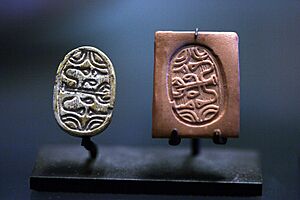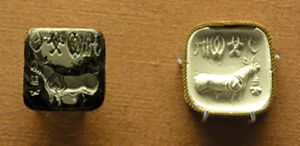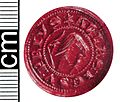Stamp seal facts for kids
A stamp seal is a small tool, often made of stone. People used it to press a unique design into soft materials like clay or wax. Think of it like a special signature or a tiny picture that proves something is real.
The oldest stamp seals were found from around 6,000 BC, which is about 8,000 years ago! They were simple, button-shaped objects with basic designs carved into them. Later, around 4,000 BC, people started using cylinder seals. These were like small rollers that you would roll over clay to make a longer design.
Stamp seals were very important in ancient times. People used them to make sure documents were real. This included things like tax papers, agreements, and official orders. Instead of a written signature, the unique design from a stamp seal showed who approved the document. These seals often had special pictures or symbols that were important to the society that made them.
Indus Valley Stamp Seals
The Indus stamp-seals are different from other ancient seals. They often have special writing on them that we still cannot fully understand today. These seals were used by the people of the Indus Valley Civilization, a very old society in what is now Pakistan and India.
Gallery
-
This stamp seal belonged to an Egyptian named Meru.
It is from the Brooklyn Museum.
See also
- Ancient Near Eastern seals and sealing practices
- Bulla (seal)
- Indus script
- LMLK seals from Lachish, ca 700 BCE.
- Scaraboid seal







